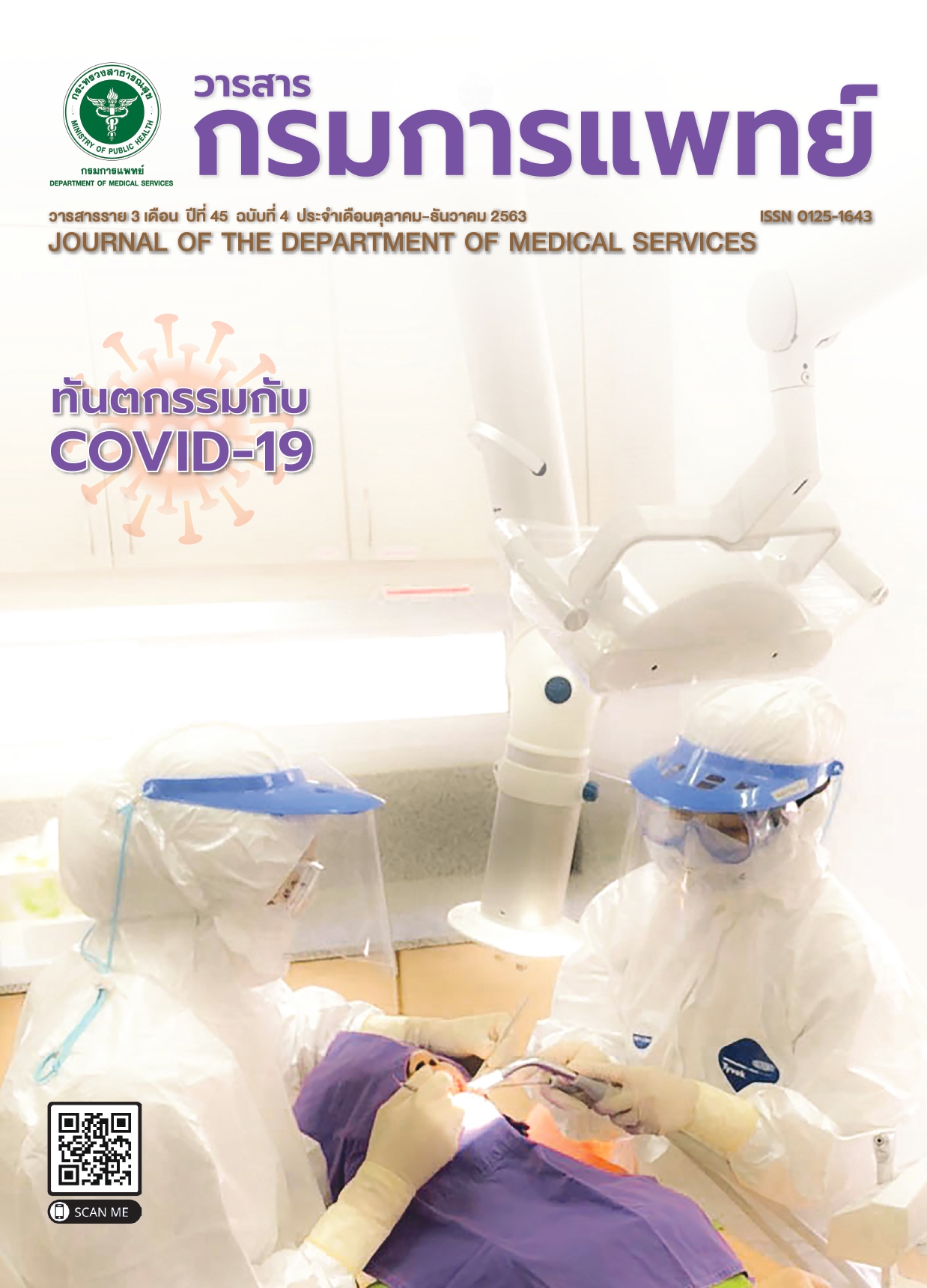Evaluation of Clinical Image Quality Following Radiation Dose Reduction in Procedures of Interventional Neuroradiology in Prasat Neurological Institute
Keywords:
Interventional Neuroradiology, Digital subtraction angiography, Radiation dose reductionAbstract
Background : Treatment of patients with complex diseases by interventional neuroradiology procedures have taken long time, which causes patients to receive high radiation dose.
Objective : To compare radiation dose to patients between care dose protocol of the factory and dose reduction protocol of Prasat Neurological Institute in Thailand and also evaluate the quality of vascular images following radiation dose reduction protocol.
Method : The acquisition care dose protocol of the digital subtraction angiography was reduced from 1.8 μGy/ frame to low dose protocol 1.2 μGy/ frame. A retrospective study of 16 patients with interventional neuroradiology procedures were conducted by selecting patients who were treated with two sessions using care dose and low dose protocols. The image quality assessment from 2 tests in term of clinical diagnosis were performed by 2 radiologists.
Result : The clinical image quality between care dose and low dose protocols in arterial phase, capillary phase, venous phase and over all image were not statistically significant. While the kerma air product (KAP) dose in the same vascular examination decreased by 26.5% and reference air kerma (Ka, r) decreased by 31.2%. When combining radiation dose in a single procedure, peak skin dose decreased by 31.99%, KAP decreased by 35.3%, reference air kerma decreased by 27.5%.
Conclusion : Low dose protocol can be used both in interventional neuroradiology procedure and cerebral angiography, allow patient to receive minimal radiation, also reduce risk of radiation complication, and still maintain quality of vascular images for diagnostic and serve treatment target.
References
Huda W. Kerma-area product in diagnostic radiology. AJR Am J Roentgenol2014;203:w565-9.
Navarro VCC, Navarro MVT, Maia AF, Oliveira ADD, Oliveira ASP. Evaluation of medical radiation exposure in pediatric interventional radiology procedures. Radiol Bras 2012 ;45:210–4.
Miller DL, Kwon D, Bonavia GH. Reference levels for patient radiation doses in interventional radiology:proposed initial values for U.S. practice. Radiology 2009; 253:753–64.
Roman T, Szajner M, Karska K, Markowicz-Roman J, Hac K, Kramarz E,et al. Radiation exposure in interventionalneuroradiology. Post N Med 2017; 4:233-6.
Ihn YK, Kim BS, Byun JS, Suh SH, Won YD, Lee DH, et al.Patient radiation exposure during diagnostic and therapeutic procedures for intracranial aneurysms: a multicenter study.Neurointervention 2016; 11:78-85.
Boonkum K, Sriiam J, Suwannasit T, Chongsaksakun Y,Suwanbundit A. Radiation dose to patient in intervention
radiology. Journal of Thai radiological technologists and nurses club in vascular and interventional radiology 2007;1:38-45.
Hassen AE, Amelot S. Radiation exposure during neurointerventional procedures in modern biplane angiography system: a single- site experience. Interv Neurol 2017;6:105-16.
Miller DL, Balter S, Cole PE, Lu HT, Berenstein A, Albert R,et al. Radiation dose in interventional radiology procedures: the RAD-IR study: part II skin dose. J Vasc Interv Radiol 2003;14:977-90.
Balter S, Hopewell JW, Miller DL, Wagner LK, Zelefsky MJ.Fluoroscopically guided interventional procedures: a review of radiation effects on patients’skin and hair. Radiology 2010;254:326-41.
Stecker MS, Balter S, Towbin RB, Miller DL, Vano E, Bartal G,et al. Guidelines for patient radiation dose management. J Vasc Interv Radiol 2009; 20:S263-73.
Honarmand AM, Shaibani A, Pashaee T, Syed FH, Hurley MC, Sammet CL, et al. Subjective and objective evaluation of image quality in biplane cerebral digital subtraction angiography following significant acquisition dose reduction in a clinical setting. J Neurointerv Surg 2016; 9:297-301.
Kahn EN, Gemmete JJ, Chaudhary N, Thompson BG, Chen K, Christodoulou EG, et al. Radiation dose reduction during neurointerventional procedures by modification of default setting on biplane angiography equipment. J Neurointerv Surg 2016; 8:819-23.
Yi HJ, Sung JH, Lee DH, Kim SW, Lee SW. Analysis of radiation doses and dose reduction strategies during cerebral digital subtraction angiography. World Neurosurg 2017; 100:216-23.
Soderman M, Holmin S, Andersson T, Palmgren C, Babic D, Hoornaert. Image noise reduction algorithm for digital subtraction angiography: Clinical results. Radiology2013;269:553-60.
Kim DJ, Park MK, Jung DE, Kang JH, Kim BM. Radiation dose reduction without compromise to image quality by alterations of filtration and focal spot size in cerebral angiography.Korean J Radiol2017; 18: 722–8.
Riabroi K, Khanungwanitkul K, Wattanapongpitak P,Krisanachinda A, Hongsakul K. Patient radiation dose inneurointerventional radiologic procedure: a tertiary care experience. Neurointervention 2018; 13:110-6.
Etard C, Bigand E, Salvat C, Vidal V, Beregi JP, Hornbeck A, Greffier J. Patient dose in interventional radiology: a multicenter study of the most frequent procedures in France.Eur Radiol 2017;27:4281-90.
Downloads
Published
How to Cite
Issue
Section
License
บทความที่ได้รับการตีพิมพ์เป็นลิขสิทธิ์ของกรมการแพทย์ กระทรวงสาธารณสุข
ข้อความและข้อคิดเห็นต่างๆ เป็นของผู้เขียนบทความ ไม่ใช่ความเห็นของกองบรรณาธิการหรือของวารสารกรมการแพทย์



